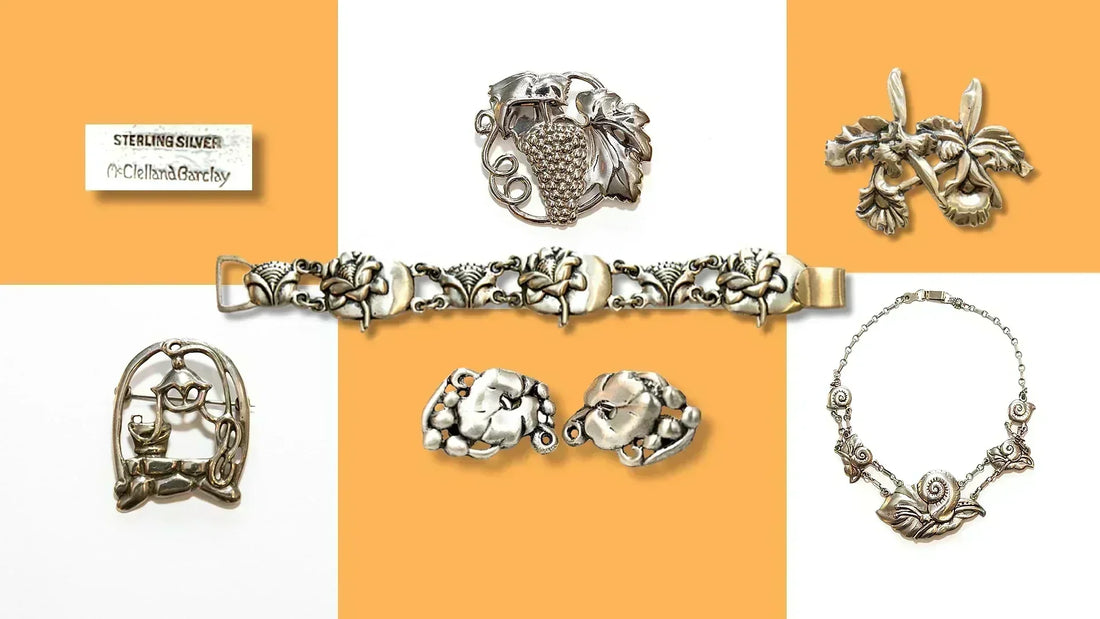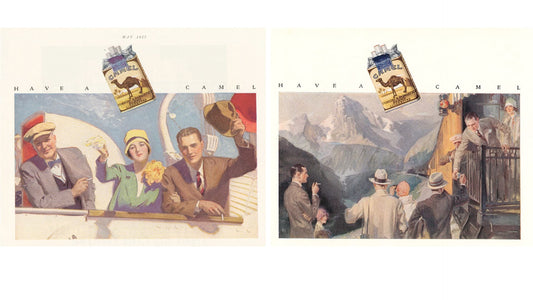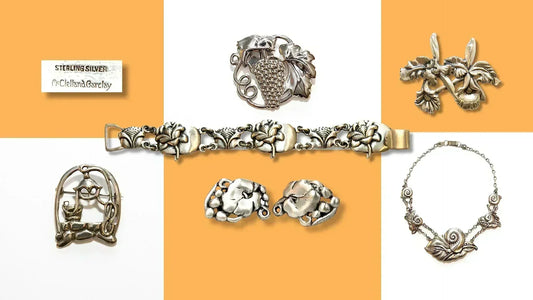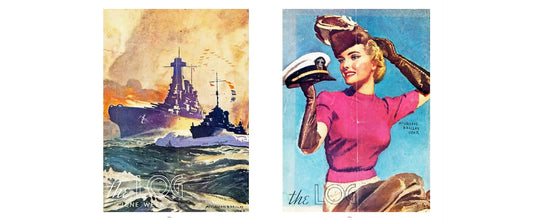
Why is McClelland Barclay sterling silver jewellery so rare?
Share
I recently gave a talk about rare McClelland Barclay sterling silver jewellery for members of the Silver Society of Canada. These kinds of talks confirm that many art collectors, curators and galleries, as well as vintage lovers are keen to know more about Mac, his art, metal decorative objects and jewellery. My expertise is gathered over twenty years researching, and literally writing the book about this Art Deco-era artist: McClelland Barclay: Painter of Beautiful Women and More.
The focus of this post is to explain the rarity of McClelland Barclay sterling silver jewellery. And I will show examples of flora, fauna and figural designs made between 1938 - 1943. But first, let me explain how I came to discover Barclay jewellery, and then learn about the maker and the man. This helps explain why all McClelland Barclay jewellery is so rare and collectible.
Blame it on Fred!
When describing my passion for collecting vintage jewellery and desire to write McClelland Barclay’s story, I have often said: Blame it on Fred!
In 1988, Fred Rezazadeh, one of the early writers about this collectibles field, wrote Costume Jewelry: A Practical Handbook & Value Guide. Capturing my attention was photo of a stunning gold-plated Art Deco style necklace. Fred's introduction included an intriguing admonition about McClelland Barclay jewellery:
“If you ever come across a piece of jewellery marked McClelland Barclay, buy it without hesitation, for if you don’t you may never see it again. McClelland Barclay jewellery is not only extremely rare, it is also among the very best costume jewellery ever made in America.”
In Fred's book, a remarkably different sterling silver wishing-well brooch (below right) was shown beside the necklace photo. The same Art Deco necklace with yellow stones (below left, and middle in a 1938 publicity photo of celebrity, Jo Stafford).
I was hooked!

I discovered McClelland Barclay jewellery in the late 1980s, just when the arrival of the internet age made collecting vintage costume jewellery very popular and more accessible than ever. But if that made it easier to shop online, why then is McClelland Barclay jewellery so collectible and expensive?
As I learned, Fred was right: McClelland Barclay jewellery is very well made, and extremely rare.
My research into McClelland Barclay jewellery
Being so captivated led me to dig further into the history of McClelland Barclay jewellery. Scouring hundreds of period issues of the trade journal Women’s Wear Daily, I found information about the 1938 launch of the McClelland Barclay jewellery collection, and the maker, Rice-Weiner & Co. of Providence, Rhode Island.
The announcement of the new McClelland Barclay jewellery collection first appeared on Friday, July 15, 1938 in Women’s Wear Daily:
“McClelland Barclay is designing a collection of 150 pieces in sterling silver and in gold which will be shown exclusively by the firm Rice-Weiner & Co.
Further research revealed the magazines where the jewellery was advertised, and where and when it was sold. On September 9, 1938, WWD announced a new collection of sterling silver jewellery by McClelland Barclay had been introduced by the New York City store B. Altman & Co. A week later, Vogue magazine published this on September 15, 1938:
There’s a huge collection of sterling silver bracelets, describing grapes, birds, et cetera, artfully, and a group of gold metal and rhinestone pieces. Most of these jewels cost about $5 and $7.50. The pièce de résistance is a charm bracelet that follows the course of true love in sterling silver, from a lady dropping her handkerchief, right on down through moon June and a group of babies. This will cost about $15.00. You may buy these at Altman. As a further incentive to acquiring one of these pieces, let it be known that each one is signed on the back by McClelland Barclay.
In 1938, fifteen dollars for a bracelet was a lot of money, when an average worker’s annual salary was about $1,500 a year. Today, this courtship charm bracelet is considered a very rare piece by McClelland Barclay.
Additional lines of jewellery by McClelland Barclay were described in early 1940’s issues of Women’s Wear Daily. These were of the Retro Moderne style in gold plated metal, usually with coloured rhinestones, and there were also more sterling silver lines.
The designs of signed McClelland Barclay sterling jewellery follow three thematic categories: flora, fauna and figurals.
Sterling silver flora jewellery

McClelland Barclay commercial paintings feature beautiful women and flowers : L: Mum deodorant (Ladies Home Journal, September 1928), R: Humming Bird hosiery, Vogue, September 1934
As in many of Barclay's paintings and commercial art works, stylized flora elements are abundant in his sterling jewellery. Designs with lilies, orchids, and other flower motifs can be found in brooches, bracelets, necklaces, earrings and rings. A beautiful parure is the heart and flowers necklace, brooch and bracelet series. (brooch and necklace shown below). Fat buds overlap a heart causing a depression in it.
Other sterling designs with natural world motifs includes woodland pine cones and needles, or oak leaves and acorns. The oak series parure included a necklace, bracelet, brooch and earrings.
 Mardee Hoff, McClelland’s favourite model at this time, who later became his romantic partner in life, is shown wearing one of his pine cone brooches in this October 1940 cover of LIFE magazine. The sterling silver pine cone pendant is shown above right.
Mardee Hoff, McClelland’s favourite model at this time, who later became his romantic partner in life, is shown wearing one of his pine cone brooches in this October 1940 cover of LIFE magazine. The sterling silver pine cone pendant is shown above right.
These designs show the influence of Scandinavian jewellery and design aesthetic. I know McClelland owned a set of Georg Jensen sterling silver cutlery. Jensen embraced the avant garde Art Nouveau style, opening a silver smithy in Copenhagen in 1904. Jensen opened a New York City store in 1923, and Barclay probably visited the shop, as he was living and working nearby during that time.
Grapes were also featured in brooches made in a smaller size or a larger one, both shown below. The small grapes brooch is contained in a beaded frame; the large grapes brooch has surrounded with curling vines and leaves.
There is also a double orchid brooch, which was from a later series. It is lighter in weight and does not have a backplate. It is stamped silver. Rings, which accompanied some of the later series, are especially hard to find, but they usually had a floral design.
Sterling silver fauna jewellery
Fauna figured prominently in McClelland Barclay sterling silver jewellery designs, although less prevalent than flora. Barclay sterling jewellery features animals of all sorts from water, on land, in the sky, and domestic animals too.
Below is a beautiful mare and colt brooch, and a pair of hunting dogs. There is a series of lamb-like animals. Birds are prominent – both fanning doves and flying geese. From the ocean, a pair of sea horses and a trio of dolphins are popular brooch design motifs, although somewhat more scarce. Snails make for a unique subject in a necklace and matching ring. An elk and an antelope are also animals featured in signed McClelland Barclay sterling silver jewellery.
McClelland himself was a dog owner, and had a lifelong love of the sea, even collecting ocean specimens for scientific research in his youth. Many examples became the small animal statuettes made by McClelland Barclay Arts Products, Inc., a metal home décor business he owned during the 1930’s.
Sterling silver figurals
Figurals refer to people and things. Miniature people can be found in the very rare courtship charm bracelet. Another figural bracelet contains puffy hearts and Americana charms.
The wishing well brooch in Fred Rezazadeh’s 1998 book is a figural. Other figurals are a shoe with a hole in it and an umbrella. This apparently had a political message that would have been understood during the Depression of the 1930’s. Playing card suits bracelet has spades, hearts, clubs and diamonds - and the jack, queen and king. The jack of clubs reappears in a small framed brooch (brooch and bracelet shown below). There was probably a whole deck of playing cards themed pieces.
The last collection made is the sterling and sterling vermeil series of five exotic head brooches. All show women wearing different types of headgear. This was the last group of signed McClelland Barclay pieces made by the Rice-Wiener Company.
A tragic end
You see, at age 52, McClelland Barclay died while aboard a supply ship in the Pacific on July 18, 1943 when it was hit by a Japanese torpedo. McClelland knew that the Pacific theatre of war was very dangerous then. He was a Lieutenant Commander in The United States Naval Reserve and was on a tour of duty, sketching life of officers and ordinary men and women on board ship. McClelland wanted to paint their life as a pictorial record of America’s war effort. He died as he had lived: his way.
The timing was tragic as McClelland’s tour of duty was to be over in about 2 weeks’ time, and Mardee Hoff was awaiting him impatiently. They had spoken of marriage and living in Hawaii, one of McClelland’s favourite places. This was a secret desire that they shared. I also share a secret about McClelland’s jewellery revealed in my book for the first time ever.
Barclay jewellery remains rare and collectible today
McClelland Barclay sterling silver jewellery is rare because it was only made between 1938 and 1943, as WWII and the loss of Barclay caused the maker to discontinue production. The quality of this jewellery made in Providence, Rhode Island by Rice-Weiner & Co. is among the best in America during that time.
This combination of scarcity and quality makes McClelland Barclay sterling silver jewellery highly collectible to this day. And now you know a how my research added a lot more to the story of McClelland Barclay, the artist, sculptor, Lieutenant Commander in the U.S. Navy Reserve, lover and painter of beautiful women...and why I believe Fred was right about his jewellery!
But, there's even more to know - its revealed for the first time ever in chapter six of my book.













